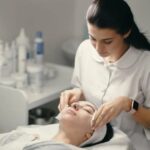PRP treatment stands for Platelet-Rich Plasma therapy. It is a non-surgical medical method used for skin and hair issues. It uses your own blood to heal and improve certain conditions. This treatment has become popular for people who want natural improvement in hair growth, PRP treatment glow, and healing of tissues. Since PRP uses your own blood, it is generally considered safe and natural.
What Is PRP Made Of
PRP is made from a sample of your blood. The doctor takes a small amount of your blood and puts it in a special machine called a centrifuge. This machine spins the blood and separates the platelets from the rest of the blood. Platelets are rich in growth factors. These growth factors help repair and heal the body. The final product is called platelet-rich plasma, which is then injected into the target area.
How PRP Treatment Works
PRP treatment works by injecting the platelet-rich plasma into the skin or scalp. These platelets release healing factors that repair tissues and help cells grow. When used on the scalp, it improves blood supply and strengthens hair roots. When used on the skin, it can help reduce fine lines, wrinkles, acne scars, and dullness. The body responds naturally to these platelets and begins to heal itself.
Uses of PRP Treatment
PRP treatment is used in many areas of medicine. It is commonly used in the following:
-
Hair loss: It helps in treating hair thinning and early-stage baldness. It is often used for both men and women who have androgenic alopecia (common hair loss).
-
Skin rejuvenation: It improves skin texture, reduces scars, and gives a youthful glow.
-
Sports injuries: It helps heal joint pain, muscle tears, and ligament damage.
-
Under-eye treatment: It reduces dark circles and puffiness under the eyes.
-
Stretch marks and scars: It helps in healing stretch marks and surgical scars.
PRP for Hair Loss
Hair fall is a common problem. PRP is becoming a popular solution for this issue. It increases blood flow to the hair roots and helps them grow stronger. The growth factors in platelets help to repair weak hair follicles. People often see visible results after three to four sessions. The hair becomes thicker, and hair fall reduces. It is not a quick fix but a gradual process.
PRP for Skin Treatment
For skin, PRP is often called a natural facial or vampire facial. It can be done on the face, neck, hands, and even back. It helps to reduce fine lines, acne scars, and open pores. It also helps to improve the skin tone and make the skin look fresh. Since PRP comes from your own blood, the chances of allergic reactions are very low.
How Many Sessions Are Required
PRP is not a one-time treatment. It usually requires multiple sessions. For hair or skin, a person may need 3 to 6 sessions spaced a few weeks apart. Maintenance sessions may be done every 6 months or once a year. The number of sessions depends on the condition being treated and how the body responds.
Benefits of PRP Treatment
-
Safe and natural as it uses your own blood
-
Non-surgical and no hospital stay required
-
Minimal recovery time
-
Effective in improving hair and skin health
-
Low risk of side effects or infections
Side Effects of PRP Treatment
While PRP is generally safe, there can be some minor side effects. These may include:
-
Redness and swelling at the injection site
-
Mild pain or soreness
-
Bruising or slight bleeding
-
Itching or sensitivity
These side effects usually go away within a few hours or days. Serious complications are rare because the plasma comes from your own body.
Who Can Get PRP Treatment
Most healthy people can take PRP treatment. However, it is not advised for people who:
-
Have blood disorders
-
Have active infections
-
Are pregnant or breastfeeding
-
Take blood-thinning medicines
-
Have certain skin conditions
It is always good to talk to a doctor before starting PRP.
Preparation Before PRP Treatment
Before the treatment, the doctor may ask you to:
-
Drink plenty of water
-
Avoid alcohol and smoking
-
Avoid anti-inflammatory medicines
-
Eat a healthy meal before the session
These steps help in getting better results and reducing side effects.
Aftercare and Recovery
After PRP treatment, most people can return to daily work. Some redness or swelling may happen, but it usually goes away in a day or two. Doctors usually give instructions like:
-
Avoid washing the treated area for a few hours
-
Avoid direct sunlight for a day or two
-
Do not apply makeup or hair products on the same day
-
Avoid heavy exercise for at least 24 hours
Following these steps helps in faster healing and better outcomes.
How Long Does PRP Result Last
The result of PRP treatment is not permanent. It helps in delaying the aging process or hair loss. The effect may last from 6 months to a year. To maintain the result, follow-up sessions are usually needed. A healthy lifestyle and proper skincare can make the results last longer.
Cost of PRP Treatment
The cost of PRP treatment depends on where you get it done, the clinic, the doctor’s experience, and how many sessions are required. Since it is considered a cosmetic procedure, it is usually not covered by insurance. Even though it may seem costly, many people find the results worth the investment.
Is PRP Better Than Other Treatments
PRP is not a replacement for all other treatments. For hair loss, it may be used along with other methods like medicines, shampoos, or hair transplants. For skin, it can be combined with microneedling or laser therapy. It is important to choose the right option based on your condition and what the doctor suggests.
Conclusion
PRP treatment is a safe and natural method to improve hair growth and skin quality. It uses your own blood to heal and regenerate cells. It does not involve surgery and has very low risk. People who are looking for natural results without heavy medicines or operations often choose PRP. Like any medical treatment, it needs to be done by a trained expert. With proper care and follow-up, it can give long-lasting and satisfying results.




